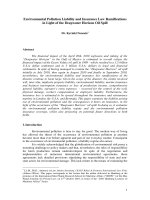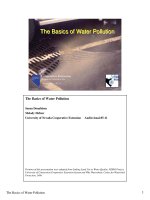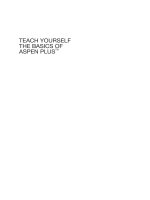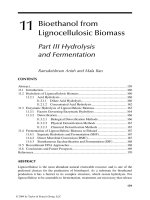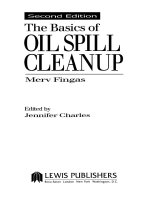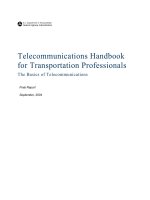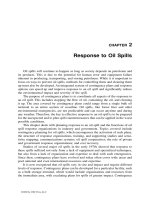The Basics of Oil Spill Cleanup - Chapter 11 ppt
Bạn đang xem bản rút gọn của tài liệu. Xem và tải ngay bản đầy đủ của tài liệu tại đây (2.03 MB, 24 trang )
©2000 by CRC Press LLC
CHAPTER
11
Shoreline Cleanup and Restoration
Oil spilled on water is seldom completely contained and recovered and some of
it eventually reaches the shoreline. It is more difficult and time-consuming to clean
up shoreline areas than it is to carry out containment and recovery operations at sea.
Physically removing oil from some types of shoreline can also result in more
ecological and physical damage than if oil removal is left to natural processes.
The decision to initiate cleanup and restoration activities on oil-contaminated
shorelines is based on careful evaluation of socio-economic, aesthetic, and ecological
factors. These include the behaviour of oil in shoreline regions, the types of shoreline
and their sensitivity to oil spills, the assessment process, shoreline protection mea-
sures, and recommended cleanup methods. Criteria of importance to this decision
are discussed in this chapter.
BEHAVIOUR OF OIL ON SHORELINES
The fate and behaviour of oil on shorelines is influenced by many factors, some
of which relate to the oil itself, some to characteristics of the shoreline, and others
to conditions at the time the oil is deposited on the shoreline, such as weather and
waves. These factors include the type and amount of oil, the degree of weathering
of the oil, both before it reaches the shoreline and while on the shoreline, the
temperature, the state of the tide when the oil washes onshore, the type of beach
substrate, i.e., its material composition, the type and sensitivity of biota on the beach,
and the steepness of the shore.
Other important factors are the existence of a high tide berm on the beach,
whether the oil is deposited in the intertidal zone, and whether the particular length
of shoreline is exposed to or sheltered from wave action. An exposed beach will
often “self-clean” before a cleanup crew can perform the task, which can result in
the released oil being transported to other beaches or even back to the same beach.
©2000 by CRC Press LLC
102
102
111
111
110
110
109
109
108
108
107
107
106
106
105
105
104
104
103
103
©2000 by CRC Press LLC
The extent to which an oil penetrates and spreads, its adhesiveness, and how
much the oil mixes with the type of material on the shoreline are all important factors
in terms of cleanup. Cleanup is more difficult if the oil penetrates deeply into the
shoreline. Penetration varies with the type of oil and the type of material on the
shoreline. For example, oil does not penetrate much into fine beach material such
as sand or clay, but will penetrate extensively on a shore consisting of coarse material.
A very light oil such as diesel on a cobble beach can penetrate to about a metre
under some conditions and is difficult to remove. On the other hand, a weathered
crude deposited on a fine sand beach can remain on the surface indefinitely and is
removed fairly easily using mechanical equipment.
The adhesiveness of the stranded oil varies with the type of oil and the degree
of weathering. Most fresh oils are not highly adhesive, whereas weathered oils often
are. Diesel and gasoline are relatively non-adhesive, crudes are generally moderately
adhesive when fresh and adhesive when weathered, and Bunker C is adhesive when
fresh and highly adhesive when weathered. An oil that is not adhesive when it reaches
the shore may get washed off, at least partially, on the next tidal cycle.
The extent of oil coverage often depends on the stage of the tide when the oil
is deposited on the shoreline. At high tide, oil can be deposited above the normal
tide line and often spreads over a broad intertidal area. The least amount of oiling
occurs when the oil is deposited on the shoreline during the falling tide, although
this is less likely to occur as the water is moving away from the shoreline. The
nature of the intertidal zone, i.e., its composition and slope, will often dictate the
fate of the oil. If large amounts of oil are not retained in the intertidal zone, then
the oil will have less impact on the area.
The fate of oil on shorelines also depends on the wave regime. Oil can be
removed and carried away by energetic waves within days whereas it can remain
for decades in sheltered areas. For example, some of the oil spilled from the
Arrow
in 1970 remains in the sheltered coves of Nova Scotia to this day. Similarly, a
significant amount of oil spilled from the
Metula
in 1974 remains on sheltered
beaches in Chile. In both cases, the oil was Bunker C and weathering produced
a crust on top of the oil. Under this crust, the oil is still relatively fresh, even after
decades.
Beaches are a dynamic environment that changes in profile during seasonal
storms. This can result in oil being buried on the beach in layers, often as deep as
1 metre, or buried oil can be brought to the surface.
Oil stranded on shorelines, especially above the high tide line, weathers with
time and becomes more adhesive, viscous, and difficult to remove. If nutrients are
present and the oil is crude, limited biodegradation can take place, but this occurs
slowly and only 10 to 30% of the oil is removed in one to two years. As oil stranded
above the high tide line is above the limit of normal wave action, physical removal
can occur only during storm events.
Opposite:
Types of Shoreline
—
Photo 102
—Bedrock;
Photo 103
—Boulder beach;
Photo104
—Pebble–cobble beach;
Photo 105
—Mixed sand gravel beach;
Photo
106
—Sand beach;
Photo 107
—Mud tidal flat;
Photo 108
—Sand tidal flat;
Photo
109
—Marsh;
Photo 110
—Peat and low-lying tundra;
Photo 111
—Mangrove
shore.
©2000 by CRC Press LLC
Photo 112
Driftwood is frequently oiled during spills and is usually cut and burned. Complete
removal of the driftwood could result in erosion on some beaches. (Environment
Canada)
Photo 113
Oil sometimes arrives on the shore in the form of tar balls. (Environment Canada)
©2000 by CRC Press LLC
Another mechanism that can significantly affect the fate of oil on shorelines is
the mixing of the oil with beach material. Oil often mixes with sand and gravel on
beaches and then weathers to form a hard, resilient material called “asphalt pave-
Photo 114
This oil from the
Arrow
spill has been on the Nova Scotia shore for more than 25
years. (Environment Canada)
Photo 115
A hole dug in this sand beach reveals layers of buried oil. (Environment Canada)
©2000 by CRC Press LLC
ment” that is difficult to remove. This material may be only 1 to 30% oil by weight,
which greatly increases the amount of material to be removed. Sometimes this
stranded oil causes no environmental concerns because the oil is entirely bound and
none is lost to the water or is re-floated, but there may be a concern with this oil
being visible on the shoreline, depending on its location.
Environmental Effects of Oil on Shorelines
Since the focus of both shoreline protection and cleanup methods is to minimize
environmental damage, the environmental effects of oil on shorelines will be dis-
cussed in this section. Biota on shorelines are harmed through direct contact with
the oil, ingestion of oil, smothering, and destruction of habitat and food sources. As
most life on the shoreline cannot avoid the oil, its destructive effects often cannot
be minimized once the oil reaches shore.
Intertidal life forms are particularly vulnerable to oil since they consist primarily
of plants and animals that move slowly or not at all. It takes from months to years
for an oiled intertidal zone to recolonize. Intertidal life may also be damaged by
cleanup efforts, particularly by the movement of people and vehicles and by cleaning
water that is either too hot or under high pressure. A cleanup method should minimize
environmental effects, not simply remove the oil at all costs. Oil should only be
removed to prevent it from being re-floated and oiling other shorelines. Oil stranded
in the intertidal zone may cause less harm if left than if removed. If the biota is
already dead, however, oil is sometimes removed so that the area can recolonize.
Oil is particularly harmful to shorebirds and mammals such as seals, sea lions,
and walruses. If the beach on which they lay their eggs or give birth to pups is oiled,
many of the young die after coming in contact with the oil. These areas are usually
given a high cleanup priority to prevent oil from reaching the shore or to remove it
quickly if it is already there.
Types of Shorelines and their Sensitivity to Oil
The type of shoreline is crucial in determining the fate and effects of an oil spill
as well as the cleanup methods to be used. In fact, the shoreline’s basic structure
and the size of material present are the most important factors in terms of oil spill
cleanup. The structural profiles of different types of shoreline are shown in Figure 29.
There are many types of shorelines, all of which are classified in terms of
sensitivity to oil spills and ease of cleanup. The types discussed here are: bedrock,
man-made solid structures, boulder beaches, pebble-cobble, mixed sand-gravel
beaches, sand beaches, sand tidal flats, mud tidal flats, marshes, peat and low-lying
tundra, and mangrove. These are illustrated in Photos 102 to 111.
Bedrock shorelines
consist of rock that is largely impermeable to oil, although
oil can penetrate through crevices or fractures in the rock. For this reason and because
plant and animal life is scarce, bedrock shorelines are not particularly vulnerable to
oil spills. Oil is more likely to be deposited in the upper tidal zone. If the shore is
exposed to wave action, a significant amount of oil is likely to be removed after
each tidal cycle.
©2000 by CRC Press LLC
Shorelines consisting of
man-made solid structures
include retaining walls,
harbour walls, breakwaters, ramps, and docks and are generally made of rocks,
Figure 29
Shoreline Profiles.
High
water
Back beach
Dunes
In
te
r
tid
a
l z
o
n
e
Berm
Sand beach
Low water
High water
Low
water
Berm
Wave-cut
rock platform
Pebble-cobble beach with rock platform
Pebble-cobble beach with mud flats
High water
Low water
M
u
d
f
la
t
s
Marsh
Berm
Beach face
Beach face
Beach face
©2000 by CRC Press LLC
concrete, steel, and wood. This type of shoreline is usually considered impermeable
to oil. Man-made structures are very similar to bedrock and are the least sensitive
of any shoreline to oil. Recolonization by biota is usually very rapid after an oiling
episode.
Boulder beaches
consist primarily of materials that are more than 256 mm in
diameter. These beaches are not altered by any conditions other than ice, human
activity, or extreme wave conditions. Boulder beaches often give way to mud or
sand tidal flats in the lower intertidal zone. Because of the large spaces between
individual boulders, oil can be carried down to the sediments and remain there for
years. Since animals and plants live in these spaces, oil often has a severe effect on
boulder beaches. Boulder beaches are considered to be moderately sensitive to oil
and do not recover rapidly from oiling.
Pebble-cobble beaches
consist of materials ranging in size from 2 to 256 mm.
Some fine materials may be present in the interstitial areas between pebbles and
there may also be large boulders in the area. Oil readily penetrates pebble-cobble
beaches through the open spaces between the rocks. Retention of the oil may be
low as it is often flushed out from the interstitial areas by natural tide or wave action.
Oil will likely concentrate on the upper reaches, however, where there is little
flushing action. As wave action constantly rearranges or reworks the sediments, few
animals and plants are present, especially in the middle intertidal zone. Pebble-
cobble beaches are not considered a sensitive beach type.
A mixed sand-gravel beach consists of a variety of materials from 0.1 to 64 mm
in size. These beaches are often called gravel beaches, because the larger gravel
appears to predominate. Only lighter oils can penetrate sand-gravel beaches and
there is reworking of sediments and few animals and plants. For this reason, these
beaches are not considered to be particularly sensitive to oil spills. Oil from past
spills can form “asphalt pavement” at the upper-tidal reaches. Oil residence times
vary, but are generally shorter than on other types of beaches. As there is generally
not an abundance of sand and gravel on these beaches, the profile of these beaches
changes little, especially in more sheltered areas.
Sand beaches
are what most people envision as a “beach.” Sand beaches occur
in every part of North America. On many coasts, they are often located between
other types of beaches. Sand is defined as a particle 0.1 to 2 mm in diameter,
consisting of several different sizes and types of minerals. Coarse sand is usually
defined as 0.5 to 2 mm in size and fine sand is less than 0.5 mm. Only lighter oils
penetrate sand beaches and the residence time is likely to be short, except when oil
is buried or carried to the upper tidal areas. Oil can easily become buried in sand
and over time this can result in layers of sand and oil, referred to as “chocolate layer
cake.” As sand beaches often do not have a high population of animals or plants,
they are not considered particularly sensitive. In recreational areas, however, sand
beaches are given a high cleanup priority if oiling of any type occurs.
Sand tidal flats
consist of material similar to sand beaches but are at shallow
angles and never drain completely. They contain a lot of silt or very fine material.
The surface layer of sand flats, which consists of a few centimetres, is dynamic and
unstable. This surface layer is usually water-saturated and thus impermeable to oils.
Some oils may adhere to the top surface or penetrate though holes made by burrowing
©2000 by CRC Press LLC
animals. Sand tidal flats are difficult to access and cleanup is therefore limited. Sand
flats are an important bird habitat and are considered to be sensitive to oil spills.
Mud tidal flats
are similar to sand tidal flats in that they are at shallow angles
and have a thin, mobile surface layer consisting of water-saturated mud that is
impermeable to oil, although oil can penetrate through holes made by burrowing
animals. Oil is likely to concentrate on the upper tidal zones. Mud flats are not
accessible to vehicles or response personnel and thus cannot be readily cleaned. If
left alone, oil is refloated and carried toward land at low tides. Like sand tidal flats,
mud tidal flats are important bird habitats and are considered to be sensitive to oil
spills.
Marshes
are important ecological habitats that often serve as nurseries for marine
and bird life in the area. Marshes range from fringing marshes, which are narrow
areas beside a main water body, to wide salt marsh meadows. Salt marsh meadows
often flood only during high tides in spring or during storm surges. Marshes are rich
in vegetation that traps oil. Light oils can penetrate into marsh sediments through
animal burrows or cracks. Heavier oils tend to remain on the surface and smother
plants or animals. Oiled marshes, fresh or salt, may take years or even decades to
recover. Marshes are difficult to access and entering them by foot or by vehicle can
cause more damage than the oil itself. They are considered sensitive to oiling.
Peat
and
low-lying tundra
are similar types of shoreline found in the Arctic
regions. Although different, they have similar sensitivity and cleanup methodologies.
Peat is a spongy, fibrous material formed by the incomplete decomposition of plant
materials. Peat erodes from tundra cliffs and often accumulates in sheltered areas
Photo 116
Marshes such as this one may be more damaged by the cleanup process than
by the oil itself. (Ed Owens)
©2000 by CRC Press LLC
as does oil. Oil does not penetrate wet peat, but dry peat can absorb large amounts
of oil. Low-lying tundra is normally dry land but is flooded by the sea at certain
times of the year. Low-lying tundra includes Arctic plants and various types of
sediment. Generally, oil does not penetrate tundra but it will adhere to dry vegetation
on the surface. Both types of shorelines are considered only moderately sensitive
to oil.
Mangroves
are tropical trees characterized by complex, interlaced root sys-
tems, parts of which are aerial and provide means for the trees to breathe. The
term “mangrove” also refers to the complex ecosystem of which the mangrove
tree is the most important component. This ecosystem can include sea grasses and
many specialized organisms that are interdependent. Oil coats the respiratory roots
of mangrove trees and kills the tree within a few days. Many of the organisms in
a mangrove ecosystem are sensitive. Mangrove areas are very difficult to access
and to clean.
Oiled Shoreline Assessment
Priorities for shoreline cleanup are based on a highly sophisticated shoreline
assessment procedure. A systematic evaluation of oiled shorelines can minimize
damage to the most sensitive shorelines. When an oil spill occurs, site assessment
surveys are usually conducted in direct support of spill response operations. These
surveys rely heavily on previously obtained data, maps, and photographs. For exam-
ple, the structure of the beach is usually already mapped and recorded as part of the
sensitivity mapping exercise for the area.
Photo 117
Oil from the massive Gulf War spill is accumulating on sand beaches behind this
breakwater. (Al Allen)
©2000 by CRC Press LLC
The following are the objectives of site assessment surveys:
• to document the oiling conditions and the physico-ecological character of the oiled
shoreline, using standardized procedures
• to identify and describe human use and effects on the shoreline’s ecological and
cultural resources
• to identify constraints on cleanup operations
• to verify existing information on environmental sensitivities or compare it with
observations from the aerial survey
A procedure for performing a site assessment survey using a Shoreline Cleanup
Assessment Team (SCAT) has been documented in the literature, including a number
of SCAT Manuals for different areas of Canada published by Environment Canada.
The SCAT concept was developed during the cleanup of the
Exxon Valdez
spill in
1989. It is a systematic and comprehensive method of data collection that can be
used to evaluate shoreline oil conditions if a spill occurs and assist cleanup personnel
to develop and plan response actions. The SCAT team usually includes an oil-spill
geomorphologist, an ecologist, and an archeologist or land-use specialist.
The SCAT team assesses the shoreline and assigns it a rating based on the degree
of oiling, environmental resources, projected tide and wind conditions, and available
transportation and other logistics. The team conducts its work according to the
following four-step plan.
The shoreline is divided into numbered segments or an existing segmentation
scheme is reviewed and adapted.
Photo 118
These rocks are completely covered with oil. (Environment Canada)
©2000 by CRC Press LLC
A daily pre-survey planning session is held at which decisions are made about
segments to survey and required equipment and supplies, existing data is reviewed,
and survey members are briefed on specific plans for the survey.
The affected area is surveyed by ground surveys, aerial reconnaissance, or aerial
videos. Usually all three methods are combined. The team completes observations
and measurements on a segment, produces a sketch map of the site, and fills in
forms or checklists of observations on the site. During the field work, the SCAT
team documents the distribution and character of stranded oil, the amount and
location of subsurface oil, shoreline characteristics, and the character of the substrate.
Ecological and human resources in the segment are documented.
After the field work is finished, all forms, maps, field notes, and photo logs are
completed and submitted, along with a daily report, to the command centre.
Shoreline Protection Measures
Shoreline protection measures are response activities carried out on or near the
shoreline, rather than on open water, to prevent the shoreline from becoming oiled
or to protect vulnerable shore resources, such as plants and wildlife. The objectives
of shoreline protection measures are to prevent oil from contacting or collecting on
certain shorelines, to minimize effects of the oil, to avoid causing more damage than
the oil would by itself, to minimize waste, and to use cleanup resources in a safe,
effective manner.
Photo 119
This shows a “pocket” beach, so called because it is small and contained. Access
to such a beach is a factor considered in the shoreline assessment process.
(Environment Canada)
©2000 by CRC Press LLC
The use of
containment booms
to deflect the oil away from sensitive shoreline
is the most common measure. If possible, oil is deflected to dock areas or loading
ramps where it is easier to recover. Oil can be deflected away from sensitive shoreline
to less sensitive shoreline, which may be easier to clean. For example, oil could be
deflected away from a marsh to a sandy section of shoreline, where cleanup would
be easier and cause less environmental damage. Booms can also be used to surround
and protect a sensitive area from the oil. Booms can only be used, however, if the
direct current does not exceed 0.5 m/s (about 1 knot) and the waves do not exceed
the boom capabilities.
The
intertidal
or
shoreline boom
is a special type of boom with a water-filled
chamber in the lower section. This chamber creates a seal between the shoreline and
the water so that oil cannot reach the shoreline. This boom can be used in some of
the same ways as regular booms, but is best used to form a barrier perpendicular to
and directly on the shore. Regular booms anchored to the shoreline are generally
ineffective because the oil can move under the boom at the shoreline-water interface.
Building
berms, ditches
, and
dams
is another way of protecting shorelines.
Berms can be constructed on a beach parallel to the water line to contain oil as it
Photo 120
Shoreline cleanup is a difficult and messy task. A good shoreline assessment can
make cleanup easier. (Oil Spill Response Limited)
©2000 by CRC Press LLC
is washed ashore or below the water line to prevent stranded oil from remobilizing.
Ditches can be dug in conjunction with berms or separately, to serve the same
purpose. Berms or dams can be built across overwash channels to keep oil out of
backshore lagoons or marshes. Berms, ditches, and dams are best used on sand
shores or shorelines with impermeable fill. Ditches could also be dug on coarse
shorelines as there is usually less permeable material under the surface. As mechan-
ical equipment is usually needed to build berms and ditches, the shoreline must be
accessible and consist of firm substrates upon which to work. Berms and ditches
are not recommended for use on sensitive shorelines such as marshes and sand or
mud tidal flats due to the intrusive and potentially damaging effects of cleanup
personnel and heavy equipment.
Geotexile materials
and
sorbent sheets
are occasionally used to protect shore-
lines. This requires lead time before the oil arrives, as well as a lot of personnel and
costly materials. This is usually done only where there is rip-rap, which is large
man-made rock material for protecting shorelines, and close to man-made structures
that would be difficult to clean. Several types of treating agents, such as waxes, have
been proposed for shoreline protection, but so far none has been very effective.
Cleanup Methods
Many methods are available for removing oil from shorelines. All of them are
costly and take a long time to carry out. The selection of the appropriate cleanup
technique is based on the type of substrate, the depth of oil in the sediments, the
amount and type of oil and its present form/condition, the ability of the shoreline
to support traffic, the environmental, human, and cultural sensitivity of the shoreline,
and the prevailing ocean and weather conditions. The cleanup techniques suitable
for use on the various types of shoreline are listed in Table 14.
The primary objective of cleanup operations is to minimize the effects of the
stranded oil and accelerate the natural recovery of affected areas. Obviously, a
Photo 121
Booms are often used to protect shoreline or to direct oil to less sensitive shoreline.
(Foss Environmental)
©2000 by CRC Press LLC
cleanup technique should be safe and effective and not be so intrusive as to cause
more damage than the oil itself. In general, cleanup techniques should not be used
if they endanger human life or safety, leave toxic residue or contaminate other
shorelines or lower tidal areas, or kill plants and animals on the shoreline. In addition,
excessive amounts of shoreline material should not be removed and the structure of
the shoreline should not be changed so as to make it unstable. Saline cleaning water
should not be used to clean freshwater beaches or vice versa. Finally, any technique
that generates a lot of waste material should not be used. In the past, heavy equipment
used on beaches resulted in thousands of tons of contaminated beach material that
then required disposal.
The length of time required to complete the cleanup is another important criterion
when selecting a cleanup technique. The longer oil is on a beach, the harder it is to
clean up. A method that removes most of the mobile oil rapidly is much better, in
many circumstances, than a more thorough one that takes weeks to carry out. Time
often dictates the cleanup method used. For example, a spill on a beach where baby
seals will be born in a few days would require the most rapid cleanup method, rather
than the method most suitable for that particular type of shoreline. Decisions on
cleaning recreational beaches are often strongly influenced by seasonal usage.
Recommended Cleanup Methods
Some recommended shoreline cleanup methods are natural recovery, manual
removal, flooding or washing, use of vacuums, mechanical removal, tilling and
aeration, sediment reworking or surf washing, and the use of sorbents or chemical
cleaning agents.
Photo 122
Oil can sometimes be distributed over a large beach area, complicating cleanup.
(Oil Spill Response Limited)
©2000 by CRC Press LLC
Table 14 Cleanup Techniques and Shoreline Types
Shoreline
Type
Condition
of the Oil
Natural
Recovery Flooding
Low-
Pressure
Cold Water
Low-
Pressure
Warm Water
Manual
Removal Vacuums
Mechanical
Removal Sorbents
Tilling/
Aeration
Sediment
Reworking/
Surf-
Washing
Cleaning
Agents
Bedrock fluid a a a b b b b c
solid c b a
Man-made fluid a a a b b b c
solid c b a
Boulder fluid a a a b b b c
solid c a
Pebble-cobble fluid a a a b b b b
solid b b c
Mixed sand-gravel fluid a a a b b b b
solid b a c
Sand beach fluid a a a b a b b b
solid b a
Sand tidal flats fluid a a a b b b
solid b b
Mud tidal flats fluid a a a b b
solid bc
Marshes fluid a a a b
solid a a a b c
Peat shorelines fluid a a a b b
or low-lying tundra solid b
Mangroves fluid a a a b b b c
solid c b a
a
Acceptable method
b
Suitable method for small quantities
c
Conditional method, may only work under special circumstances
©2000 by CRC Press LLC
Sometimes the best response to an oil spill on a shoreline may be to leave the
oil and monitor the
natural recovery
of the affected area. This would be the case
if more damage would be caused by cleanup than by leaving the environment to
recover on its own. This option is suitable for small spills in sensitive environments
and on a beach that will recover quickly on its own such as on exposed shorelines
and with non-persistent oils such as diesel fuel on impermeable beaches. This is not
an appropriate response if important ecological or human resources are threatened
by long-term persistence of the oil.
Manual removal
is the most common method of shoreline cleanup. Teams of
workers pick up oil, oiled sediments, or oily debris with gloved hands, rakes, forks,
trowels, shovels, sorbent materials, hand bailers, or poles. It may also include
scraping or wiping with sorbent materials or sifting sand to remove tar balls. Workers
wear protective clothing such as splash suits, boots, gloves, and respirators if the
oil is volatile. Material is usually collected directly into plastic bags, drums, or
buckets for transfer.
Oil can be removed manually from almost any type of shoreline, although this
method is most suitable for small amounts of viscous oil and surface oil and in areas
inaccessible to vehicles. While removing oil manually is a slow process, it generates
less waste than other techniques and allows cleanup efforts to be focused only on
oiled areas. A disadvantage is the risk of injuries to personnel from falls on slippery
and treacherous shorelines.
Photo 123
Manual labour is often used to clean up boulder beaches such as this one. (Ed
Owens)
©2000 by CRC Press LLC
Flooding
or
washing shorelines
are common cleanup methods. Low-pressure
washing with cool or lukewarm water causes little ecological damage and removes
oil quickly. Warmer water removes more oil, but causes more damage. High pressure
and temperature cause severe ecological damage and recovery may take years. It is
preferable to leave some oil on the shoreline than to remove more oil but kill all the
biota with high pressure or temperature.
Low-pressure cool or warm water washing uses water at pressures less than about
200 kpa (50 psi) and temperatures less than about 30°C. Water is applied with hoses
that do not focus the water excessively, avoiding the loss of plants and animals.
Flooding is a process in which a large flow or deluge of water is released on the upper
portion of the beach. Water can be applied to the beach using hoses without nozzles
to reduce the impact of the spray. Sometimes a special header or pipe is used to
distribute the water. Booms are then used to contain the flow and direct the recovered
oil to a calm area where it can be recovered with mechanical skimmers.
Low-pressure washing and flooding are often combined to ensure that oil is
carried down the beach to the water, where it can be recovered with skimmers.
Washing and flooding are best done on impermeable shoreline types and are not
useful for shorelines with fine sediments such as sand or mud. These techniques are
not used on shorelines where sensitive plant species are growing.
Several sizes of
vacuum systems
are useful for removing liquid oil that has
pooled or collected in depressions on beaches and shorelines. Small vacuum units
Photo 124
Washing shorelines with cold water at moderate pressures can be an effective
technique for crude oils. The oil is being flushed to skimmers for recovery. (Ed
Owens)
©2000 by CRC Press LLC
are available that are specially designed for use on shorelines. The suction hose is
usually applied manually to those areas where oil can be removed. Vacuum trucks
used for collecting domestic waste are often used to remove large pools of recovered
oil rather than for recovering oil directly on the beach. For safety reasons, vacuums
should not be used for oils that are volatile.
Mechanical removal
involves removing the surface oil and oiled debris with
tractors, front-end loaders, scrapers, or larger equipment such as road graders and
excavators. Graders and bulldozers are sometimes used on long straight stretches of
recreational sand beaches, where they quickly windrow oiled sand. Front-end loaders
and backhoes are used on a variety of beaches to move oiled materials and to expose
buried material as well as to remove materials recovered manually from the beach.
Draglines and clamshells are used for these purposes on shorelines that are accessible
from barges.
While mechanical devices remove oil quickly from shorelines, they also remove
large amounts of other material and generate more waste than other techniques. Sand
and sand-gravel shorelines are best suited to this technique as they can support
mechanical equipment and are not usually damaged by the removal of material.
Mechanical equipment should not be used on sensitive shorelines, shorelines with
an abundance of plant and animal life, and shorelines that would become unstable
if large amounts of material are removed.
Specialized shore-cleaning equipment is available that is equipped with rakes,
elevating conveyors, or spiked drums to remove oil and oily sand from sand shore-
lines. Although these devices are more selective than earth-moving equipment, they
still remove more material than would be removed by hand labour. These devices
do have the potential, however, to clean small amounts of tar balls from many miles
of beaches in a single day.
Photo 125
This hot water flushing operation was carried out during the
Exxon Valdez
cleanup.
Although this method removed the oil, re-colonization by plants and animals was
slow. (Ed Owens)
©2000 by CRC Press LLC
Photo 126
Although a grader can remove oiled sand very quickly, large amounts of oiled sand
must then be disposed of. (Ed Owens)
Photo 127
This cleanup crew is sifting tar balls out of the sand. (Foss Environmental)
©2000 by CRC Press LLC
Tilling and aeration
are used to break up surface layers or to expose subsurface
oil. The exposed oil can then weather naturally and degrade, and will not leach into
the water. Medium to heavy oils that form crusts are also broken down and “asphalt
pavement” buried in the beach is exposed. This work is done with farm equipment,
such as ploughs, discs, and cultivators and construction equipment such as bulldozers
or graders with rippers. The technique is suitable for sand, sand-gravel, or pebble-
cobble beaches.
Sediment reworking
or
surf washing
is another method that involves the use
of mechanical equipment. Oiled material is moved from the upper tidal zone, where
it would remain for many years, down to the intertidal zone where the oil will be
washed out by the surf. While this is usually done with graders or front-end loaders,
it can be done manually. This method is useful on sand-gravel or sand beaches where
the oil has been moved above the normal high-tide line by a storm surge or very
high tide. It is also used on recreational beaches that must be restored rapidly. As
the oil is released from the sediment and could potentially contaminate other shore-
lines, this technique is not appropriate if other locations or plants and animals could
be endangered.
Photo 128
A vacuum system is used to remove oil from a beach. (Oil Spill Response Limited)
©2000 by CRC Press LLC
Sorbents
are used in several ways in beach cleanup. In a passive role, sorbents
are left in place, on or near a beach, to absorb oil that is released from the beach
by natural processes and prevent it from recontaminating other beaches or contacting
wildlife. Sorbent booms as well as “pom-poms” designed for heavy oil can be staked
on the beach or in the water on the beach face to catch oil released naturally. This
is effective but labour-intensive and produces a large amount of waste material.
Loose sorbents such as peat moss and wood chips are generally not used because
they may sink and migrate into non-oiled areas and are difficult to recover.
Chemical cleaning agents called
beach cleaners
or
surface-washing agents
with low toxicity to aquatic organisms have recently been developed. These agents
typically contain a surfactant and low-toxicity solvent. They act by inserting mole-
cules between the oil and substrate, thus lessening the adhesion to the surface and
partially dissolving the oil. They are applied at low tide, allowed to soak into stranded
oil, and then low-pressure washing is used to move the oil to the water where it is
recovered with skimmers. High-pressure washing could cause the oil to disperse,
which is also true of other chemical products. This is usually considered undesirable.
Approval from the appropriate environmental agencies is often required before these
agents can be used.
Less Recommended Cleanup Methods
Other more drastic methods, which have a greater impact on the environment,
are available for cleaning up shorelines. These methods may be required in certain
circumstances but are less recommended than the techniques already discussed.
High-pressure cold or hot water washing
has been used in the past to clean
some beaches. While very effective, especially the hot water washing, the technique
removes most of the plant and animal life along with the oil, leaving the treated
Photo 129
Sorbents are being deployed along this beach to trap oil released by the tides.
(Ed Owens)
©2000 by CRC Press LLC
stretch of shoreline sterile. The technique is therefore not used on any sensitive
shoreline or where the recolonization would be slow. In locations where this may
be the only way to remove oil, it may be preferable to leave the oil than to remove
it in this harsh manner.
Steam-cleaning
and
sand blasting
are similar methods in that they remove
almost any type of oil from any type of shoreline, but destroy plant and animal life
in the process. These methods are usually used only on man-made structures such
as piles, piers, jetties, or walls.
Vegetation cutting
is sometimes carried out in marshes and other areas where
plant life is threatened by oiling, especially by heavy oils. Plants can be saved in
this way, although traffic into marshes or other sensitive areas can cause severe
damage. It is only used if it can be done without causing damage by access and if
it removes oil that could re-contaminate this or other areas.
In-
situ
burning
is useful if the water level is high and the burn residue is either
removed or does not suppress future plant growth. Oil will not burn on a typical
beach unless the oil is pooled or concentrated in sumps or trenches with a minimum
thickness of 2 to 3 mm.
In-situ
burning can be sustained in marshes when the oil is
pooled and when the marsh plants will burn. In fact, burning is a useful restorative
method for marshes if done in spring when the water level is high so that the heat
does not affect the plant roots. Burning in late summer or early fall, however, can
kill much of the plant life. An alternative is to flood the marsh using berms and
pumps, which will raise up some of the oil for burning.
Photo 130
Small vacuum units are used to remove oil from the water near this beach. (Oil
Spill Response Limited)
©2000 by CRC Press LLC
While
chemical agents
other than beach cleaners or surface-washing agents are
sometimes suggested for shoreline cleanup, they should not be used as they are not
effective and can cause additional problems. Dispersants generally increase the
penetration of the oil, which makes them unsuitable for use on shorelines. Solidifiers
or recovery agents do not assist with oil recovery.
Bioremediation
has been used for years to remove oil from shorelines. It can
be used on all types of shoreline but works only with light to medium oils that have
a high saturate fraction. Generally, much of the saturate content of these oils bio-
degrades. The remaining oil usually consists of larger saturates, aromatics, resins,
and asphaltenes, and remains to form asphalt pavement.
Biodegradation can be enhanced by applying fertilizers, in a manner similar to
that described in Chapters 9 and 12. Fertilizers that are soluble in water will rapidly
dissipate into the water, however, and can cause accelerated algal growth in nearshore
waters. This can be avoided by using slowly dissolving pellets at the upper tidal
reaches or oil-soluble fertilizers, although these are more expensive and less avail-
able. The effects of bioremediation are not noticeable for a long time, usually at
least one season after the fertilizers have been applied.
